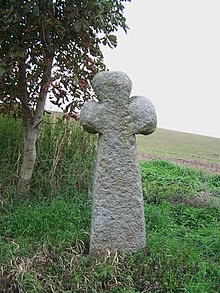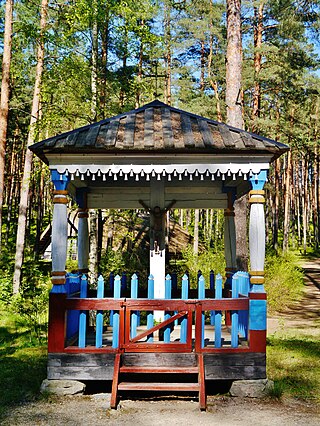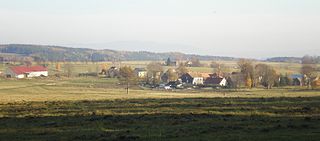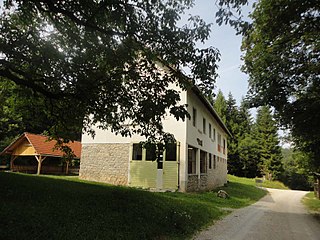
Conciliation cross, also known as roadside cross or penitence cross, is a stone cross, which was set up in a place where a murder or accident had happened. It occurs mainly in Central Europe.

Conciliation cross, also known as roadside cross or penitence cross, is a stone cross, which was set up in a place where a murder or accident had happened. It occurs mainly in Central Europe.
In the Middle Ages and in the early modern period, the conciliation crosses were erected as a symbol of penance for crime, most often for murder. If the perpetrator of the murder was not punished according to the law, he concluded a contract with the family of the victim or with the town council, which included the obligation to erect a stone cross. The culprit usually had to create it by his own hands. [1] [2]
Many of the conciliation crosses are associated with local legends. They are considered to be one of the oldest monuments of law in the Czech lands. [1]
In 1983, the Society for the Research of Stone Crosses was established under the auspices of the Aš Museum in the Czech Republic. The society created a register of stone crosses in the Czech Republic and takes care of their protection. The company registers 2,685 conciliation crosses in the Czech Republic and 273 in other countries, especially in Central Europe. [3] [4]
The conciliation cross near Jaroměř is considered the largest in the Czech Republic. [2] It has a height of 1.67 m (5 ft 6 in). [5]

Central Europe is a geographical region of Europe between Eastern, Southern, Western and Northern Europe. Central Europe is known for its cultural diversity; however, countries in this region also share certain historical and cultural similarities.

Charles University, also known as Charles University in Prague or historically as the University of Prague, is the oldest and largest university in the Czech Republic. It is one of the oldest universities in Europe in continuous operation. Today, the university consists of 17 faculties located in Prague, Hradec Králové, and Plzeň. Charles University is in the top three universities in Central and Eastern Europe.

Charles Bridge is a medieval stone arch bridge that crosses the Vltava river in Prague, Czech Republic. Its construction started in 1357 under the auspices of King Charles IV, and finished in the early 15th century. The bridge replaced the old Judith Bridge built 1158–1172 that had been badly damaged by a flood in 1342. This new bridge was originally called Stone Bridge or Prague Bridge, but has been referred to as "Charles Bridge" since 1870.
Trial in absentia is a criminal proceeding in a court of law in which the person who is subject to it is not physically present at those proceedings. In absentia is Latin for "in (the) absence". Its meaning varies by jurisdiction and legal system.

Děčín is a city in the Ústí nad Labem Region of the Czech Republic. It has about 47,000 inhabitants. It is the 7th largest municipality in the country by area. Děčín is an important traffic junction.

Aš is a town in Cheb District in the Karlovy Vary Region of the Czech Republic. It has about 13,000 inhabitants.

Jaroměř is a town in Náchod District in the Hradec Králové Region of the Czech Republic. It has about 13,000 inhabitants. It is known for the Josefov Fortress. Josefov is well preserved and is protected by law as an urban monument reservation, the historic town centre of Jaroměř is procected as an urban monument zone.
Statistics Denmark is a Danish governmental organization under the Ministry of the Interior and Housing, reporting to the Minister of Economic and Internal Affairs. The organization is responsible for creating statistics on the Danish society, including employment statistics, trade balance, and demographics.

The history of the Jews in the Czech lands, historically the Lands of the Bohemian Crown, including the modern Czech Republic, goes back many centuries. There is evidence that Jews have lived in Moravia and Bohemia since as early as the 10th century. Jewish communities flourished here specifically in the 16th and 17th centuries, and again in the late 19th and early 20th centuries. Local Jews were mostly murdered in the Holocaust, or exiled at various points. As of 2021, there were only about 2,300 Jews estimated to be living in the Czech Republic.

A wayside shrine is a religious image, usually in some sort of small shelter, placed by a road or pathway, sometimes in a settlement or at a crossroads, but often in the middle of an empty stretch of country road, or at the top of a hill or mountain. They have been a feature of many cultures, including Chinese folk religious communities, Catholic and Orthodox Europe and some Asian regions.

Kbelany is a municipality and village in Plzeň-North District in the Plzeň Region of the Czech Republic. It has about 100 inhabitants.

Lesní Hluboké is a municipality and village in Brno-Country District in the South Moravian Region of the Czech Republic. It has about 300 inhabitants.

Polná is a village in Karlovy Vary Region, Czech Republic. It is one of the six municipality districts of Hazlov. In 2001 the village had a population of 45.

Podstenice is a settlement in the Municipality of Dolenjske Toplice in Slovenia. It was inhabited by Gottschee Germans. At the start of the Second World War its population was expelled and in 1942 the village was burned to the ground. The area is part of the historical region of Lower Carniola. The municipality is now included in the Southeast Slovenia Statistical Region.

ANO 2011, often shortened to simply ANO, the initials meaning Action of Dissatisfied Citizens, is a populist political party in the Czech Republic. The party has been labelled as centrist on the political spectrum by some sources, while others state that it is a centre-right party. At the European level ANO is a member of the Alliance of Liberals and Democrats for Europe Party and the Renew Europe group in the European Parliament. The party is led by entrepreneur Andrej Babiš, who served as Prime Minister in 2017–2021.

A wayside cross is a cross by a footpath, track or road, at an intersection, along the edge of a field or in a forest. It can be made of wood, stone or metal. Stone crosses may also be conciliation crosses. Often they serve as waymarks for walkers and pilgrims or designate dangerous places.

The Single Resolution Mechanism (SRM) is one of the pillars of the European Union's banking union. The Single Resolution Mechanism entered into force on 19 August 2014 and is directly responsible for the resolution of the entities and groups directly supervised by the European Central Bank as well as other cross-border groups. The centralised decision making is built around the Single Resolution Board (SRB) consisting of a chair, a Vice Chair, four permanent members, and the relevant national resolution authorities.

Stone crosses in Central Europe are usually bulky Christian monuments, some 80–120 cm (31–47 in) high and 40–60 cm (16–24 in) wide, that were almost always hewn from a single block of stone, usually granite, sandstone, limestone or basalt. They are amongst the oldest open-air monuments. A larger variant of the stone cross, with elements of a wayside shrine is called a shaft cross (Schaftkreuz).

The Marian column of Prague is a religious monument consisting of a column topped with a statue of the Virgin Mary, located in the city's Old Town Square. The original column was erected in 1650, shortly after the conclusion of the Thirty Years' War. It was demolished in November 1918, coinciding with the fall of Austria-Hungary. In 2020, the column was reconstructed, being completed on 15 August 2020.